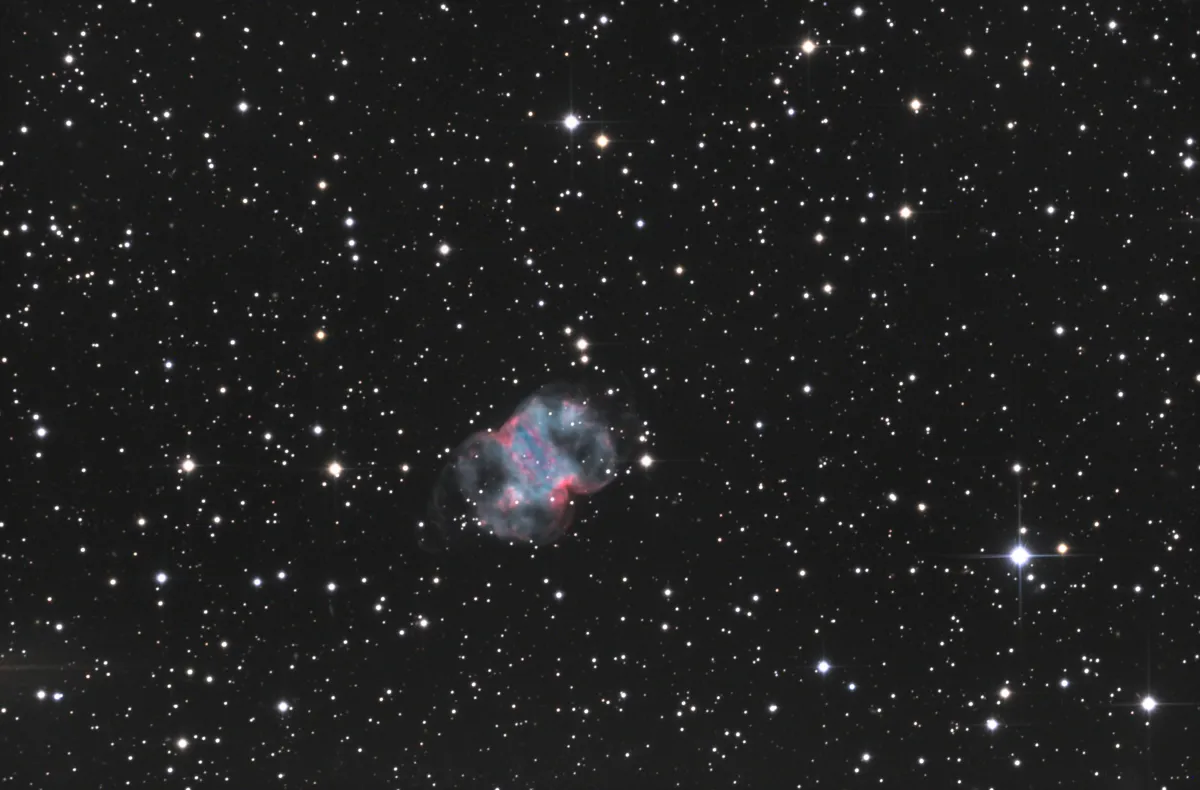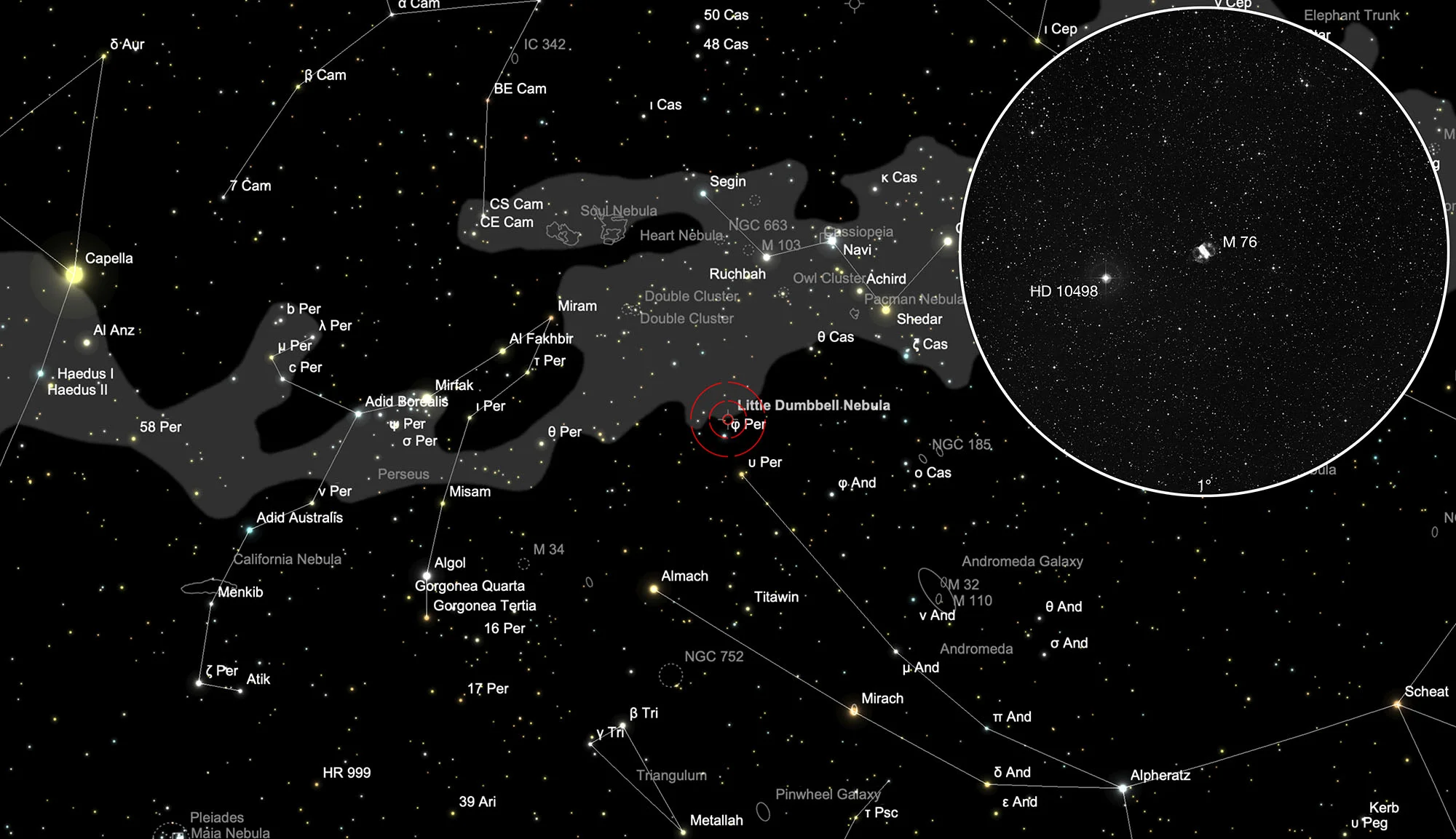Little Dumbbell Nebula (Messier 76)

History
M 76 was discovered by Pierre Méchain. Charles Messier wrote: «Nebula at the right foot of Andromeda, seen by M. Méchain on 5 September 1780, and he reports: This nebula contains no stars: it is small and faint. On the following October 21, M. Messier looked for it with his achromatic telescope, and it seemed to him that it consisted only of very small stars containing nebulae, and that the slightest light to illuminate the wires of the micrometer made it disappear: the position was determined on the basis of the fourth great star ψ Andromeda.» [281]
William Herschel observed this nebula on 12 November 1781 with his 18.7 inch reflector telescope, recorded the entry I 193 and noted: «Two close to each other. Both very bright, distance 2' leading south, following north. One is 76 from the Connoissance» [464] Herschel's son John listed this «double nebula» as GC 385 and GC 386 in his «Catalogue of Nebulae and Clusters of Stars» [467] published in 1864, the first being identified as M 76 and the second as WH I 193 This was then adopted by John LE Dreyer in his «New General Catalogue» [467] in 1888. The American astronomer Heber Doust Curtis finally identified M 76 as a planetary nebula on photo plates from the Lick Observatory in 1918. [461]
Physical Properties
This bipolar planetary nebula is known by different names: Cork Pin Nebula or Small Dumbbell Nebula, the little brother of the Dumbbell Nebula (M 27). The sharply delimited, central, rectangular section contrasts with the large tuft-like appendages that appear as two overlapping ellipses. The central star has a photographic brightness of 16.5 mag and about 0.6 to 0.9 solar masses at a temperature of 100'000 to 170'000 Kelvin. Looking at the appearance of the nebula with the measured velocities of different areas of the nebula, it is difficult to imagine how the structure emerged from secretions from the central star. There are several models, but none are unique. M 76 is located about 2500 light years from Earth and measures about 0.7 light years in diameter. [283]
| Designations | PN G130.9-10.5: NGC 650-51, PK 130-10.1, ARO 2, M 76, VV 6, VV'9 |
| Right Ascension (J2000.0) | 01h 42m 21s a |
| Declination (J2000.0) | +51° 34' 07" a |
| Dimensions | 67." (optical), 100." (radio) |
| Distance | 1.2 kpc |
| Radial Velocity | -19.1 ± 1.2 km/s |
| Expansion Velocity | 38.5 (O-III) 40. (N-II) km/s |
| C-Star Designations | AG82 11 |
| Discoverer | CURTIS 1918 |
Finder Chart
M 76 is located in the constellation Perseus about 1° north of the 4 mag bright star φ Persei. The PN is circumpolar, but the best time to observe it is June to March when it is highest in the sky at night.
Visual Observation
400 mm aperture: With a 21 mm Ethos eyepiece (85x), the nebula and its bipolar shape can be clearly seen without a filter. In the 9 mm Nagler eyepiece (200x) it looks like a cork. Without the O-III filter I like the sight better, because the nebula appears embedded in fine stars all around. With the O-III filter, about as much of the nebula can be seen as without. The bright star HD 10498 glares when it is in the field of view. In the 6 mm Radian eyepiece (300x) the nebula appears darker in the central area than at the edge. On the side with the little star nearby, the nebula looks a little lighter. The beginnings of the ears are more palpable than recognizable. — Taurus T400 f/4.5 Dobsonian, Hasliberg Reuti, 6. 11. 2021, Bernd Nies
